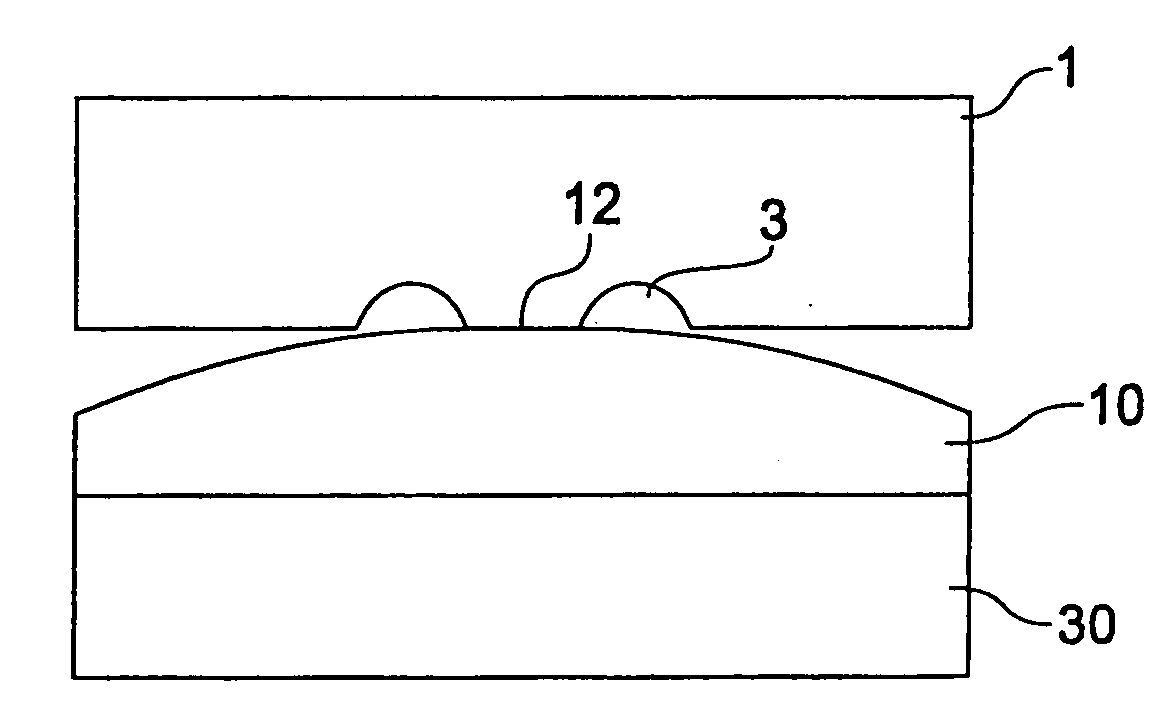Method and apparatus for forming an optical element and substrate and moulding tool
- Summary
- Abstract
- Description
- Claims
- Application Information
AI Technical Summary
Benefits of technology
Problems solved by technology
Method used
Image
Examples
embodiment 1
[0081] For pressing a planar array of cylindrical lenses (diameter 30 mm) with aspherical cylinder lenses, a glass preform having the same diameter, a planar surface and a convex surface with a radius of curvature of 300 mm is pressed. The convex surface faces the die with the array of cylinder lenses.
[0082] The heights of the cylinder lenses is 0.3 mm. Due to the curvature of the glass preform an additional pressing distance of proximately 0.4 mm has to be passed. The hot-forming is performed under a nitrogen atmosphere for preventing corrosion of the forming tools.
[0083] It has been observed that the aspherical surfaces of the cylinder lenses could be formed without any roughness due to inclusion of nitrogen.
embodiment 2
[0084] For pressing an aspherical imaging lens a glass preform having the same diameter (70 mm), a planar surface and a convex surface with a radius of curvature of 45 mm is pressed. The convex side faces the die with the array of cylinder lenses. Due to the curvature of the glass preform an additional pressing distance of approximately 0.3 mm has to be passed. It has been observed that aspherical surfaces could be formed without any roughness due to inclusion of nitrogen. Generally, the height of the structures is given by: z(r)=cr21+1-(1+k)c2r2+α1r2+α2r4+… αnr2n
wherein:
[0085] Z: height of lens,
[0086] C: curvature,
[0087] K: conical parameter.
[0088] In the embodiment the parameters were chosen as follows:
[0089] c=1 / 36.409;
[0090] k=−1;
[0091] a2=1.08E-06
[0092] a4=2.16E-10
[0093] a6=−5.19E-15
wherein B270 was used as glass.
embodiment 3
[0094] For molding diffractive optical elements (DOE) on an aspherical imaging lens, an aspherical lens (designed according to embodiment 2) was used. The planar surface was coated with plastic material and subsequently structured by a DOE form using a molding process as described above. The planar surface faced the die with the DOE. Due to the curvature of the glass preform, an additional molding distance of approximately 0.05 mm had to be passed. It has been observed that DOEs without any roughness due to inclusion of nitrogen could be produced. The phase function of the DOEs is given by:
φ(r)=−6.75r2+0.001045r4
wherein f[rad] and r: 0-35 mm.
[0095] Referring to FIG. 9 in the following an exemplary imaging optics comprising at least one optical element produced according to the present invention will be described. Referring to FIG. 9, the imaging optics comprises three optical lenses disposed one behind the other, wherein the first lens is a convex-convex lens having a radius of c...
PUM
| Property | Measurement | Unit |
|---|---|---|
| Temperature | aaaaa | aaaaa |
| Pressure | aaaaa | aaaaa |
| Structure | aaaaa | aaaaa |
Abstract
Description
Claims
Application Information
 Login to View More
Login to View More - R&D
- Intellectual Property
- Life Sciences
- Materials
- Tech Scout
- Unparalleled Data Quality
- Higher Quality Content
- 60% Fewer Hallucinations
Browse by: Latest US Patents, China's latest patents, Technical Efficacy Thesaurus, Application Domain, Technology Topic, Popular Technical Reports.
© 2025 PatSnap. All rights reserved.Legal|Privacy policy|Modern Slavery Act Transparency Statement|Sitemap|About US| Contact US: help@patsnap.com



